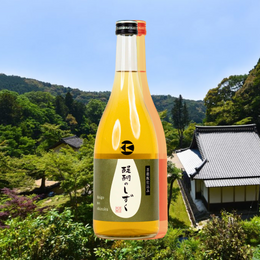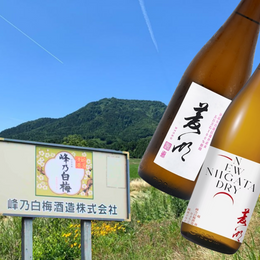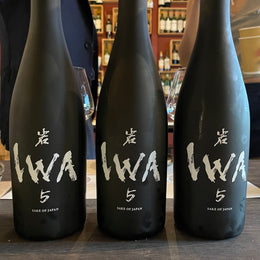
Senkin Brewery, often referred to as Domaine Senkin, is a favourite among sake connoisseurs, renowned for its emphasis on a "domaine" approach to crafting sake using ingredients sourced locally. The brewery is also known for pushing boundaries, producing sakes with exceptionally low polishing ratios or developing unusual flavour profiles that challenge convention.
Founded back in 1806, Senkin is the oldest operating brewery in Tochigi Prefecture, lying north of Tokyo and known for its beautiful natural landscapes and rich agricultural heritage. When the sake-making business was handed over to Kazuki Usui and his brother in the 2000s, the senior Usui wasn’t holding his breath. Sake sales had been steadily dwindling and it didn’t help that the family-owned brewery was only known for making mass-produced table sake of generic quality. There was little hope that the fate of the business would change within the hands of the 11th generation owner.

The Usui brothers who made Domaine Senkin the revered producer that it is today.

The elder son would prove his father wrong. Kazuki, with his background as a French wine sommelier, became a pioneer in introducing French wine-inspired concepts into the world of sake. He directly challenged conventional sake-making sensibilities and championed sakes with lactic sourness. The result were sakes with a vibrant, zesty character, often compared to high-acid white wines from Alsace and Germany, regions renowned for their crisp Riesling and Gewürztraminer.
“Domaine Senkin”
Taking the reins of Senkin Shuzo at just 28, Kazuki faced a daunting challenge. The family brewery was staring down the barrel of liquidation and consumption was declining, particularly among younger generations who were increasingly drawn to wine, beer and whisky. Ironically, the fact that Kazuki had no prior experience in sake production became an advantage for the brewery. Unburdened by traditional dogma, Kazuki approached sake with fresh eyes and a palate attuned to the nuances of flavour and aroma. He wasn't bound by the conventions of what sake "should" taste like; he was free to explore new possibilities.

While working as a wine sommelier in the early noughties, Kazuki noticed a stark contrast between how sake and wine were treated in restaurants. Wine lists were curated with an appreciation for the diversity and complexity of various grape varietals, regions and terroir. Sake lists, on the other hand, seemed to be chosen purely based on brand popularity, with little consideration for the unique characteristics of the rice or how the place it was grown might make a difference. Winemakers placed a far greater emphasis on their ingredients – the grapes, the soil, the climate – than sake makers typically did.
Kazuki realised that there was an opportunity for Senkin (not to mention little to lose): by focusing on the unique characteristics of the rice and the local environment – the water and the climate – one could create sakes that were truly expressive of their origin.
Kazuki began referring to what was Senkin Shuzo as “ Domaine Senkin”. This wasn't just about borrowing fancy wine terminology. The Burgundian concept of "domaine" denotes a wine estate where the ingredients (grapes) are grown locally and meticulously sourced. By adopting this concept, Kazuki sought to emphasise the connection between the brewery, the land and the final product, elevating Senkin to become a custodian of its local terroir.

This commitment to terroir is reflected in Senkin's sourcing of ingredients. Under Kazuki, Senkin became hyper-local, using only rice the brewers are deeply familiar with, grown a mere five-minute drive from the brewery. Senkin also turned to a practice known as "aishoku," where the same water source is used for both cultivating the rice and brewing the sake, believed to create a closed loop that further strengthens the connection between the sake and its place of origin.
The attention to detail extends to the seemingly mundane stages of production, such as the meticulous washing and soaking of the rice. These are processes that are often overlooked, but Senkin insists they would eventually have a profound impact on the sake's flavour and aroma.
A “modern” sake made with ancient methods
Younger drinkers were getting increasingly adventurous, and to hold their attention, Kazuki needed something more tangible than fancy French wine terminology.
Now, for years, nobody – not Kazuki’s father or his grandfather – wanted high acidity in sake. Sake brewing had been focused on achieving smooth, mellow sweetness and umami notes, with acidity traditionally perceived as a flaw or a sign of instability. But Kazuki, the rebel with a sommelier's palate, saw things differently. The younger generation, raised on a more diverse cosmopolitan diet, had developed different palates. They were growing up with more meat, fried foods, and condiments like ketchup and mayonnaise, exploring the flavours of French, Indian, Italian, and other global cuisines.

An essential step of kimoto sake-making. The mash is rhythmically mixed using long paddles to combine yeast, water, rice and koji while naturally promoting lactic acid development.
Traditional sake, with its lower acidity, often struggled to hold its own against these richer, heavier flavours. Younger consumers were also seeking out more diverse and complex flavour profiles in their beverages which traditional sake did not provide. And so, Kazuki began championing higher acidity in sakes, pioneering a "sweet-and-sour-sake" concept. This new high-acid sake – often with a lactic sour bite – offered more complexity and liveliness, cut through richer Western foods and created harmonious balance.
But don't think for a minute that Senkin's pursuit of acidity involves any gimmicky newfangled techniques or shortcuts. Quite the contrary, Senkin’s amazuppai sake (sweet-sour style sake) is made possible by adopting the abandoned ancient kimoto method of sake-making, a slow and laborious fermentation method that eschews artificial additives and relies on cultivating natural lactic acid bacteria and yeast in the rice mash. To be as authentic as possible, Senkin also switched from using metal tanks to wooden barrels for fermentation, allowing the porous wood and microflora to impart subtle flavours and complexities to the sake. The resulting sakes are described as having a vibrant, almost electric acidity, reminiscent of a fine Riesling with its tart, fruity profile.

Kazuki’s unofficial motto has been "new meets old." This approach has kept Senkin ahead of the curve, blending modern methods with time-honoured traditions. Just to prove their dedication to tradition, besides the use of kimoto, Senkin also moved towards traditional elements like genshu (undiluted sake) and muroka (unfiltered sake), styles that showcase the sake in its purest form.
Initially, the new style of sakes introduced by Kazuki was met with raised eyebrows and more than a few disapproving murmurs, including from his father. However, Kazuki stuck to his guns: he saw how Senkin was attracting new drinkers who didn’t usually drink sake, such as younger people and women. The numbers eventually spoke for themselves: this new style of sake caught on and took the sake world by storm, challenging preconceptions and captivating a new generation of sake drinkers. Senkin's production surged a hundredfold within just 10 years.
Senkin’s sakes
Senkin’s product lines are divided into three main series: Classic, Modern and Nature.
Both the Classic and Modern series are crafted using the same locally sourced rice with similar polishing ratios. The Classic series, true to its name, embraces the traditional kimoto method we discussed earlier. The Modern series, on the other hand, opts for the contemporary sokujo method, which employs commercially prepared lactic acid for a faster fermentation process.

The Nature series is particularly interesting. This is where Senkin truly lets the ingredients shine and allows the natural characteristics of the rice and the environment to take centre stage. These sakes are organic and additive-free, and made using kimoto. They're also made from kame-no-orice, a once-forgotten rice variety known for producing more austere, authentically rice-forward sakes.

Click here to read our review of the Senkin Nature Organic Sake.
For this review, we're having a side-by-side tasting of both the Senkin Classic Muku Genshu, and the Senkin Modern Muku Genshu. "Muku" simply means "unadulterated" and in the context of sakes usually implies that it has been crafted with minimal intervention to emphasise the flavour of the local ingredients. "Genshu" is also pretty straightforward and means that the sake had not been diluted with water after brewing – the equivalent of the term "cask strength" in whiskies. And as mentioned earlier, the Classic is made using the Kimoto method, expected to have a vibrant acidity. The Modern is made using the sokujo method expected to produce a cleaner and lighter sake.
We got a taste these two bottles at Sake Matsuri Singapore 2024.
Senkin Classic Muku Genshu, 15% ABV – Review
60% polishing rate Yamadanishiki rice, Kimoto method.

Tasting Notes
Nose: Sweet, fruity and lightly earthy. Aromas open with a distinct ricey ginjoka scent with a wave of ripe melon and soft creamy sweetness of a freshly peeled banana. There's a subtle nuttiness of toasted almonds or cashew in the background.
Palate: A delightful duality on the palate with satisfying presence without feeling heavy. Medium bodied with a moderately thick creamy texture and a generously flavoured palate. Initial impressions are laden with this fresh, rustic rice porridge earthy sweetness, balanced by the refreshing tang of some lactic acidity. Creamy banana notes from the nose reappear with a touch of lychee cream cake.
Finish: The finish is short and clean, with a light touch of vanilla and fading earthy rice notes.

My Thoughts:
This is a rather elegant sake with complex aromatics, a satisfyingly creamy and intricate palate with some of that signature rustic lactic sourness that Senkin is known for, although it's pretty understated and integrated along with the fruitiness and riceyness.
The palate is generous and rich in texture, yet also very fresh. The subtle layers of ricey rusticity and earthiness also allow it to harness the natural flavours of the rice and koji along with the fruitiness of it. The earthiness and substantial texture of this would help this pair exceptionally well with umami-rich foods - think brie cheese or miso-marinated cod fish.
Senkin Modern Muku Genshu, 15% ABV – Review
50% Yamadanishiki rice, Sokujo method.

Tasting Notes
Nose: Initial impressions are creamy and mellow with a brighter fruity sweetness to it. It opens with the scent of freshly steamed rice and vanilla yoghurt, followed by grapefruit, juicy green muscat grapes and meringue. All enveloped in a light, sweet milky creaminess.
Palate: Medium-bodied, remarkably clean and crisp. A very mild sweetness of rice porridge alongside fresh notes of green honeydew and snow pear. A mild milky creaminess of gently warmed milk and a light lactic note emerge as well. There's a defining dryness to this, like biting into the zest of a citrus with a clean pithy dryness that cuts right through the sweetness and creaminess.
Finish: Short and clean with distinct aftertaste of cooked pearl barley, reminiscent of the aftertaste in a light German-style lager. A light lactic note fading with the karakuchi dryness.

My Thoughts:
This is pretty distinctive. The nose is delightfully complex and captivating, though the palate is what offers an interesting point of contrast from the Senkin Classic. While the Classic offers a richer, more textured experience, the Modern delivers a lively and refreshing palate. It's got brighter fruit notes and a distinct dryness while retaining Senkin's signature lactic acidity. The finish is also particularly satisfying with its clean barley character.
It's the kind of sake that would be perfect on a hot day or enjoyed outdoors, its crispness cutting through the heat and humidity.

@CharsiuCharlie







